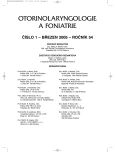Testing Olfaction Merkers by Means of Perfumed
Authors:
J. Vodička 1; P. Zajíčková 2; J. Šalandová 3
Authors‘ workplace:
Klinika ORL a chirurgie hlavy a krku, Krajská nemocnice Pardubice
; přednosta prof. MUDr. A. Pellant, DrSc.
Neurologické oddělení, Krajská nemocnice Pardubice
1; primář doc. MUDr. E. Ehler, CSc.
Centrum pracovního lékařství, Krajská nemocnice Pardubice
2; primářka MUDr. J. Šalandová
3
Published in:
Otorinolaryngol Foniatr, 54, 2005, No. 1, pp. 47-51.
Category:
Original Article
Overview
Summary:
We examined olfaction in 100 people using perfumed markers (six odours), which are commonly available in stationeries. The test consists of two parts, odour discrimination and odour identification. The test of odour discrimination was conducted with two of the six markers. One of them was presented two times and person was asked to tell the sequence of the odour, which he/she smelled only once. The sequence was changed then and examination was repeated with the other four markers. The highest score to reach was 9 points. The test of odour identification was conducted with three of the six markers. The examined person was asked to name the odours first. Then he/she was presented with the same odours, but in different sequences and was asked to recognize them. This part was repeated with the other three markers. The highest score a person could get in the odour identification part was 18 points.
Our set of the examined people was compounded from staff and patients from Department of Otolaryngology and Head and Neck Surgery, Neurology and Centre of Occupational Medicine. The range of points the people could gain was from zero to 27. a Higher score meant a better odour discrimination and identification. People (50 persons), who did not smoke and did not suffer from any disease, which could influence smell ability (healthy and non smokers – HN) reached average score 20.7 points. The rest of the patients (RP, 50 persons) reached average score 14.2 points. HN were divided in three subgroups depending on their age. The lowest average score reached people older than 60 years. The score of the RP was in correlation with the subjectively assessed smell ability.
Based on our first results we conclude that our test can serve for orientational evaluation of the olfaction.
Key words:
parfumed merkers, olfectometry.
Labels
Audiology Paediatric ENT ENT (Otorhinolaryngology)Article was published in
Otorhinolaryngology and Phoniatrics

2005 Issue 1
Most read in this issue
- Relapsing Middle Cervical Cyst and Atypical Position of Hyoid Bone
- Central Hearing Loss in Children with Developmental Dysphasia
- Testing Olfaction Merkers by Means of Perfumed
- Present Classification of Laser Cordectomy
